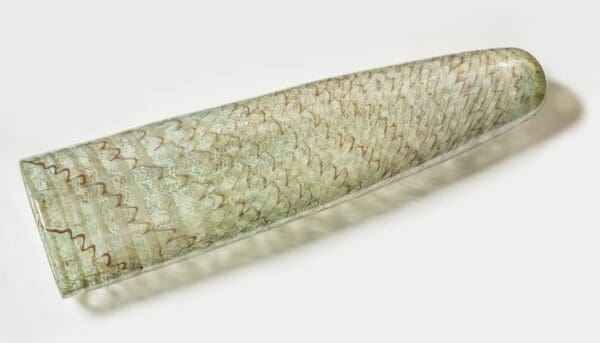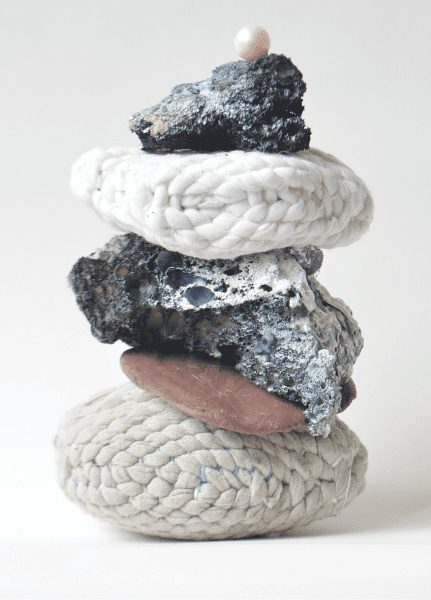
Jennifer Kemarre Martiniello’s Glass Acts
Telstra National Aboriginal and Torres Strait Islander Art Awards 2025 finalist Jennifer Kemarre Martiniello has spent decades crafting an art practice that weaves together memory, heritage and form.
In a tiny outbuilding at the artist’s Melbourne home, Brooks’s studio is briskly cold on a midwinter’s day, yet the colours and materials piled inside are warmly engaging. There are small, colourful drawings pinned to the walls, showing stacks of shapes. On the shelves are miniature soft sculptures, like bonsai Claes Oldenburgs thanks to their culinary references. And huddling nearby are piles of hairy, holey constructions that seem to have crash-landed from an alternate reality.
He straddles concerns once traditionally assigned either/or to ‘art’ or ‘craft.’ Perhaps because of his deep knowledge of looming, he knows well how to loop one with the other.
One of his abiding interests is the concept of the portal, the entry from one space – physical, psychological or philosophical – to another, hence the frequency with which holes appear in his works. His recent explorations include shaggy blue yetis jumping through portals, incorporated into a video work that sits inside a weaving.
Brooks’s journey to this place began with training a decade ago at the Melbourne School of Fashion, after which he studied weaving at RMIT in the textile development diploma, and then moved to a Bachelor of Fine Art (Drawing) at the Victorian College of the Arts. He went on to do honours in visual arts at Monash University in 2014 but, throughout it all, has maintained a cross-disciplinary emphasis.
With fashion, he says he had a naive understanding of how the industry works and, before doing his fine art degree, realised the textile design industry wasn’t for him. During his honours year, he engaged with a challenging area: exploring how the history of textiles is expressed through alternate realities, especially as found in science fiction and fantasy literature, such as the work of Jorge Luis Borges and Philip K Dick.

Bouncing off this, he began to incorporate video, sculpture and two-dimensional work into discrete pieces. “Now I am trying to bring collage and drawing back into the work,” Brooks says. “I like the push and pull between a visceral and an intellectual reaction, and I like merging things that are seen as opposites. When I was younger, I thought it was all about disproving binary thinking, but that’s a really huge area that will take a lot longer to work with.”
Brooks’s success has been impressive. He has shown solo at Craft Victoria, Mailbox Art Space, Kings, Rubicon and Bus Projects, and generated a buzz with his arresting forms and ideas. He is about to be artist-in-residence at the Australian Tapestry Workshop, and earlier this year had an extraordinary – and blood-freezing – time as artist-in-residence at the Icelandic Textile Center in Blönduós, on the coast north-east of Reykjavik.
“There was nothing else to do there but make work,” he recalls. “We were locked away with our looms while it snowed.”
While there, he saw an enormous construction of stones stacked one upon the other that intrigued him. Was it, as a friend there wondered, a set of markers to guide people lost in the snow, or a sculpture made by a corrupt politician during his jail sentence? Brooks never enquired further: he liked the ambiguity, and stacked forms are beginning to thread throughout his work. They are, however, soft.
“I am not very precise with hard materials; they are difficult to manipulate,” he says. “There is something about soft textures. I really enjoy rubbing paint through them or embedding them in latex, so they have something abject about them. You want to touch them but you are also a little bit repulsed. That push and pull excites me.”
It is no surprise, then, that he is presently exploring “blobs”, a word that came to mind when he was looking at ideas around Darwinian evolution and the beginnings of life in the oceans during what is known as the ‘Cambrian Explosion’, 530 million years ago. He is investigating moons and pearls, and the possibilities for pink fur, and encouraging us, as viewers, to actually put our heads inside portals in his work.
Perhaps then we might enter the interesting world of John Brooks: soft, enveloping and full of challenging ideas.